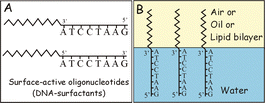Adsorption and hybridisation of DNA-surfactants at fluid surfaces and lipid bilayers
Abstract
In this paper, we explore the properties of a novel class of functional

* Corresponding authors
a
Surfactant & Colloid Group, Department of Chemistry, University of Hull, Hull, UK
E-mail:
V.N.Paunov@hull.ac.uk
Fax: +44(0) 1482 466410
Tel: +44 (0) 1482 465660
In this paper, we explore the properties of a novel class of functional

 Please wait while we load your content...
Something went wrong. Try again?
Please wait while we load your content...
Something went wrong. Try again?
C. Xu, P. Taylor, P. D. I. Fletcher and V. N. Paunov, J. Mater. Chem., 2005, 15, 394 DOI: 10.1039/B412151A
To request permission to reproduce material from this article, please go to the Copyright Clearance Center request page.
If you are an author contributing to an RSC publication, you do not need to request permission provided correct acknowledgement is given.
If you are the author of this article, you do not need to request permission to reproduce figures and diagrams provided correct acknowledgement is given. If you want to reproduce the whole article in a third-party publication (excluding your thesis/dissertation for which permission is not required) please go to the Copyright Clearance Center request page.
Read more about how to correctly acknowledge RSC content.
 Fetching data from CrossRef.
Fetching data from CrossRef.
This may take some time to load.
Loading related content
